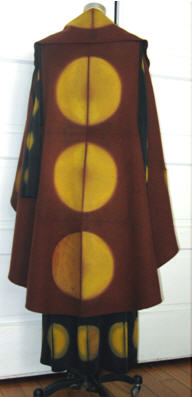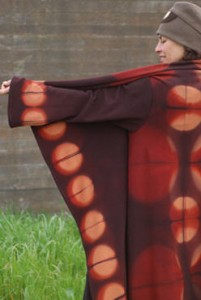The power of the itajime technique in Angelina DeAntonis’ Ocelot dress and cape ensemble is fluid and strong. The special combination of wool, silk and natural dyes creates a majestic feel and presentation. Yellow, rust-brown and black are the distinctive colors created from osage, cochineal, cutch, iron & logwood, and acid dyes for the deep red-black of the silk dress. Their sources range from acacia wood, trees from the great plains and insects to modern chemistry.

Ocelot dress and cape-photo courtesy of the artist
Angelina founded the Ocelot clothing line in 1998, crafting hand-dyed itajime technique on all-natural fibers. From the showcase to the showroom, the observer quickly learns that Angelina’s craft is not only compelling to the eye, but comfortable to wear. The line embodies the spirit of the ocelot, native to the central and south American continent. In the same spirit, these garments have traveled the world both in exhibits and on customers. Each has Angelina’s personal touch – intense yet comforting, vibrant and subdued- a compendium of opposites that has a unique balance which beckons to be worn.
Angelina integrates many natural dyes into the itajime, and is brewing some new recipes for pieces for the home that use 100% natural dyes, with a more rustic look than the refined clothing line. In her travels in India, Mexico, and Bolivia she has investigated first hand the current natural dyeing of the textiles being produced. And a recent workshop she taught in Canada at the Maiwa studio has inspired some new experiments in itajime, inspired by some interesting things the students explored.
Angelina shared her thoughts on the exhibit and her creative journey.
CC: Many of the exhibit pieces are clothing items that span hundreds of years – each hand dyed with a purpose, whether for ceremony or of necessity. What was the inspiration for including the specific dress and cape ensemble that you chose for the exhibit?
AD’A: The pieces I made for the exhibit I chose because they really feature a bold and stunning pattern. The itajime is dyed into the whole garment. I was working with large and heavy pieces of fabric, which is heavy work. They are pieces that are ceremonial in the sense that one would wear them to a special event. I felt that I needed to make an outfit that would entice the viewer to imagine the significance of wearing it.
CC: Do you feel you had the intention of hand dyeing a clothing line, or did it evolve through a discovery/creative process? At what point was it clear to you that creating Ocelot was what you wanted to do?
AD’A: I had wanted to create a line of clothing that used natural dyes and plant fibers. When I started dyeing, the itajime patterns flowed naturally. It was not my initial intention to focus on pattern, but I did like the idea of bold pattern that could transform the body, reflecting a different scale that would somehow relate to the environment. The itajime patterns were very compelling, and a world of possibilities opened up by having a focus and distinct look.
CC: You teach dyeing workshops as well. What attracted you to Itajime? Do you look at your work as carrying on a tradition, or creating new applications to a traditional art?
AD’A: When I have taught, I have focused on the use of natural dyes in a very technical way. I show various ways of folding and resisting, but I want to really get the students thinking about all the possibilities.
I am fascinated by the historical traditions in Japanese itajime, but that is not my focus. The itajime process is a technique that gives form to my sensibility of design; intensity of contrast, bold shapes that speak a universal language in their simplicity. It is a tool. I have been largely self-taught in fold and clamp resist dyeing, so I am evolving my work out of my own experience.
The tradition I carry on is the centuries old use of using plants and insects for dyeing. That is what connects me to cultural dyeing traditions.
CC: A lot of people can get easily discouraged if a project doesn’t come out exactly the way they envision it – what advice would you give to them to continue the creative process?
AD’A: The process of creating is exactly that; it is a process. So when things go wrong, there is the opportunity to take your vision into a new territory. One must be constantly observing the materials and how they respond to the dyes, the folding, and so on.
The vision of what we want, and making those changes once the material world is involved, is both the challenge and the reality. So the ability we have to discover and re-think is a strength, and can invigorate the making experience. I think that is something artists covet about creating; the unknown can reveal many possibilities and become a journey of discovery, which is very compelling.
Editor’s note: to see more of Angelina’s clothing and where to purchase it, go to her website-www.ocelotclothing.com.
To read more about the show, click Judith Content
